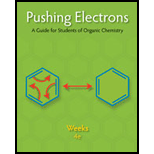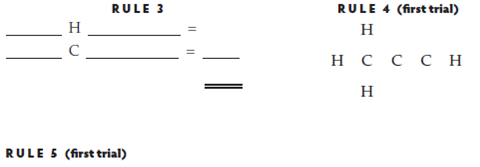
Pushing Electrons
4th Edition
ISBN: 9781133951889
Author: Weeks, Daniel P.
Publisher: Cengage Learning
expand_more
expand_more
format_list_bulleted
Concept explainers
Textbook Question
Chapter 1, Problem 20EQ
Using the method outlined above, derive the structures for the following compounds. The unbounded skeletons are provided.
Propyne

No. of electrons in structure _____
No. of valence electrons _____
Structure is ___________ (correct, incorrect)
(Second trial) (third trial)
______ ______
___________________ ______ _____________________ ______
Structure is _____________ Structure is __________________
Expert Solution & Answer
Trending nowThis is a popular solution!

Students have asked these similar questions
Chapter #12, Question #4:
Water from a lake in an area with limestone bedrock has a chemical composition as on p. 310. If the organic matter (HM) content of the water is 12 mg L-1, show that charge balance is adequately maintained.
***If you find that charge balance is not maintained from the tabulated concentrations, calculate the carboxylate concentration (CCOO−) in the HM.
___________ containers must be used to package allmaterials suspected of containing hydrocarbonresidues.
, aminobenzene sulfonic acid will be synthesized, called sulfanilic acid. This will be done by (1) sulfonating an aniline with sulfuric acid. The first step in this reaction will be the formation of salt, anilinium bisulfate (2). When the salt becomes heated, it will then produce sulfanilic acid (3). Since the compound will contain both an acidic group, -SO3H, and a basic group, -NH2, an internal acid-base reaction can produce a dipolar ion (4).
What is the mechanism for this reaction using proper curved arrow notation?
Chapter 1 Solutions
Pushing Electrons
Ch. 1 - 1. Hydrogen is a Group I element and each...Ch. 1 - Methanol has the molecular formula CH4O. Its...Ch. 1 - 3. The skeleton of chloromethane is...Ch. 1 - 4. Methanol’s skeleton is
Connecting all bonded...Ch. 1 - 5. The structure for chloromethane is
It...Ch. 1 - Prob. 6EQCh. 1 - 7. Dimethyl ether
No. of electrons in...Ch. 1 - Methylamine (CH5N) No. of electrons in structure...Ch. 1 - Methanethiol (CH4S) No. of electrons in structure...Ch. 1 - Methylal (C3H8O2) No. of electrons in structure...
Ch. 1 - Prob. 11EQCh. 1 - Adding electrons to the skeleton by making single...Ch. 1 - This is done by removing an unshared pair from...Ch. 1 - Prob. 14EQCh. 1 - Prob. 15EQCh. 1 - Prob. 16EQCh. 1 - The skeleton of acetyl chloride is . Write the...Ch. 1 - Three constitutional isomers exist for the formula...Ch. 1 - A number of constitutional isomers exist for the...Ch. 1 - Using the method outlined above, derive the...Ch. 1 - Prob. 21EQCh. 1 - Prob. 22EQCh. 1 - Prob. 23EQCh. 1 - Prob. 24EQCh. 1 - The skeleton of benzyldimethylamine is
The...Ch. 1 - The skeleton is benzaldoxime is The number of...Ch. 1 - Prob. 27EQCh. 1 - Derive Lewis structures for the compounds below....Ch. 1 - Prob. 29EQCh. 1 - Derive Lewis structures for the compounds below....Ch. 1 - Prob. 31EQCh. 1 - Derive Lewis structures for the compounds below....Ch. 1 - The Lewis structure of acetone is Circling the...Ch. 1 - Chloromethane has the Lewis...Ch. 1 - In the Lewis structure for chloromethane, the...Ch. 1 - Prob. 36EQCh. 1 - The oxygen atom in acetone possesses ____ unshared...Ch. 1 - Nitrobenzene has the skeleton
The number of...Ch. 1 - Prob. 39EQCh. 1 - Compute and add on the formal charges I these...Ch. 1 - Prob. 41EQCh. 1 - Prob. 42EQCh. 1 - Prob. 43EQCh. 1 - Prob. 44EQCh. 1 - Prob. 45EQCh. 1 - Prob. 46EQCh. 1 - Prob. 47EQCh. 1 - Compute and add on the formal charges in these...Ch. 1 - Prob. 49EQCh. 1 - Prob. 50EQCh. 1 - The n-propyl cation can be formed from a molecule...Ch. 1 - Prob. 52EQCh. 1 - Prob. 53EQCh. 1 - Methanol, CH3OH, is a compound in which the formal...Ch. 1 - When a proton becomes bonded to diethyl ether, by...Ch. 1 - Tetrahydrofuran has the structure
When a proton...Ch. 1 - Prob. 57EQCh. 1 - Prob. 58EQCh. 1 - The structure of pyridine is
When a proton...Ch. 1 - The carbon atom owns one electron from each of ...Ch. 1 - The n-butyl anion can be formed from When the CLi...Ch. 1 - The isobutyl anion can be formed from When the CNa...Ch. 1 - Prob. 63EQCh. 1 - Ethanol, , is a compound in which the formal...Ch. 1 - The loss of a proton attached to the oxygen atom...Ch. 1 - A very strong base can remove a proton from...Ch. 1 - Prob. 67EQCh. 1 - Prob. 68EQCh. 1 - Prob. 69EQCh. 1 - The homolysis of the OO bond in diacetyl peroxide...Ch. 1 - Prob. 71EQCh. 1 - Prob. 72EQCh. 1 - Prob. 73EQCh. 1 - Prob. 74EQCh. 1 - Prob. 75EQCh. 1 - Heterolytic cleavage of the CO bond to yield a...Ch. 1 - Prob. 77EQCh. 1 - Prob. 78EQCh. 1 - Prob. 79EQCh. 1 - Prob. 80EQ
Knowledge Booster
Learn more about
Need a deep-dive on the concept behind this application? Look no further. Learn more about this topic, chemistry and related others by exploring similar questions and additional content below.Similar questions
- give the nomenclature or the structure of the following molecules of item #21 to #25.arrow_forwardPlease name the structures, any help with this would be great!arrow_forwardIn parts 1 and 2 draw the two organic products of this reaction, showing any nonzero formal charges. Then, in part 3 answer the question regarding purification of the reaction mixture. 1. Draw the product with the higher molecular weight here 2. Draw the product with the lower molecular weight here 3. Which method would be the simplest and most effective means to best separate the two products? (extraction, recrystallization, chromatography, distillation)arrow_forward
- Directions: Write the correct Lewis structure and show the step-by-step solution on how you came up with the structure. SOCl2 - primarily used as a chlorinating reagentarrow_forwarda. Use bond energies (see Table 3-3) to estimate H for the reaction of two molecules of glycine to form a peptide linkage. b. Would you predict S to favor the formation of peptide linkages between two molecules of glycine? c. Would you predict the formation of proteins to be a spontaneous process?arrow_forwardWrite the structure of the monomer used in the synthesis of : (i) Nylon-6 (ii) Nylon-6, 6arrow_forward
- 6de High density polyethylene (HDPE) fiber is used as liners for surgical gloves. Although the liner has a very high resistance to being cut, the polymer allows a surgeon to maintain a delicate sense of touch. The HDPE liner is usually rigid and not flexible. (JUST SIMPLY ANSWER THE QUESTION BELOW) 1. How do chemists control the production of LDPE and HDPE? 2. Besides the extent of branching, what are other structural parameters that might lead to differences in physical properties of LDPE and HDPE?arrow_forwardAcetylene is a very weak acid; however, it will react with moist silver(I) oxide and form water and a compound composed of silver and carbon. Addition of a solution of HCl to a 0.2352-g sample of the compound of silver andcarbon produced acetylene and 0.2822 g of AgCl.(a) What is the empirical formula of the compound of silver and carbon?(b) The production of acetylene on addition of HCl to the compound of silver and carbon suggests that the carbon is present as the acetylide ion, C22− . Write the formula of the compound showing the acetylide ion.arrow_forwardChemistry The compound YBa2Cu3O7 is known as a defect perovskite. What does this mean if you were to describe the structure of “YBCO”? Based on what you have learned from the solid-state modeling kits, what can be said about the building blocks of compounds like these?arrow_forward
- Structural Isomers: Alkanes One of the reasons for the complexity of carbon compounds is that it can bond (catenate) with itself. Oils are mostly made up of hydrocarbons, for 'saturated' compounds, these obey the formula CnH2n+2. The empirical formula (unlike benzene) will vary with n. Now we have established C is tetrahedral, how many structural (skeletal) isomers can we find for n=6, hexane C6H14 ? 1) Sketch all the isomers. What procedure did you use to make sure you didn’t miss any ? Do you think you could you do this now for heptane C7H16 ?! (Hint: 9 different ‘skeletal’ topologies) Note the number of possible isomers increases in highly exponential way. C10 – 75 isomers C15 – 4,347 isomers C20 - 366,319 isomers !! Note:- • Do not provide handwritten solution. Maintain accuracy and quality in your answer. Take care of plagiarism. • Answer completely. • You will get up vote for sure.arrow_forwardIn the Cahn-Ingold-Prelog Convention, used for determining enantiomers and E/Z isomers, bromine would be outranked by __________. chlorine nitrogen oxygen iodine carbonarrow_forwardwhich carbons are tertiary (3°) and quaternary (4°)?arrow_forward
arrow_back_ios
SEE MORE QUESTIONS
arrow_forward_ios
Recommended textbooks for you


 Chemistry: An Atoms First ApproachChemistryISBN:9781305079243Author:Steven S. Zumdahl, Susan A. ZumdahlPublisher:Cengage Learning
Chemistry: An Atoms First ApproachChemistryISBN:9781305079243Author:Steven S. Zumdahl, Susan A. ZumdahlPublisher:Cengage Learning ChemistryChemistryISBN:9781305957404Author:Steven S. Zumdahl, Susan A. Zumdahl, Donald J. DeCostePublisher:Cengage Learning
ChemistryChemistryISBN:9781305957404Author:Steven S. Zumdahl, Susan A. Zumdahl, Donald J. DeCostePublisher:Cengage Learning



Chemistry: An Atoms First Approach
Chemistry
ISBN:9781305079243
Author:Steven S. Zumdahl, Susan A. Zumdahl
Publisher:Cengage Learning

Chemistry
Chemistry
ISBN:9781305957404
Author:Steven S. Zumdahl, Susan A. Zumdahl, Donald J. DeCoste
Publisher:Cengage Learning
Chapter 4 Alkanes and Cycloalkanes Lesson 2; Author: Linda Hanson;https://www.youtube.com/watch?v=AL_CM_Btef4;License: Standard YouTube License, CC-BY
Chapter 4 Alkanes and Cycloalkanes Lesson 1; Author: Linda Hanson;https://www.youtube.com/watch?v=PPIa6EHJMJw;License: Standard Youtube License